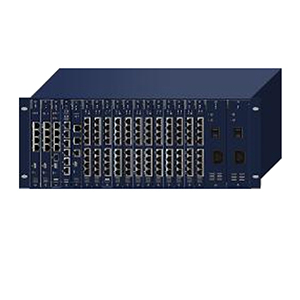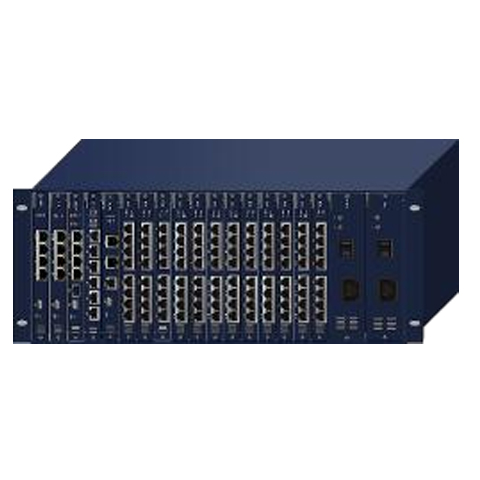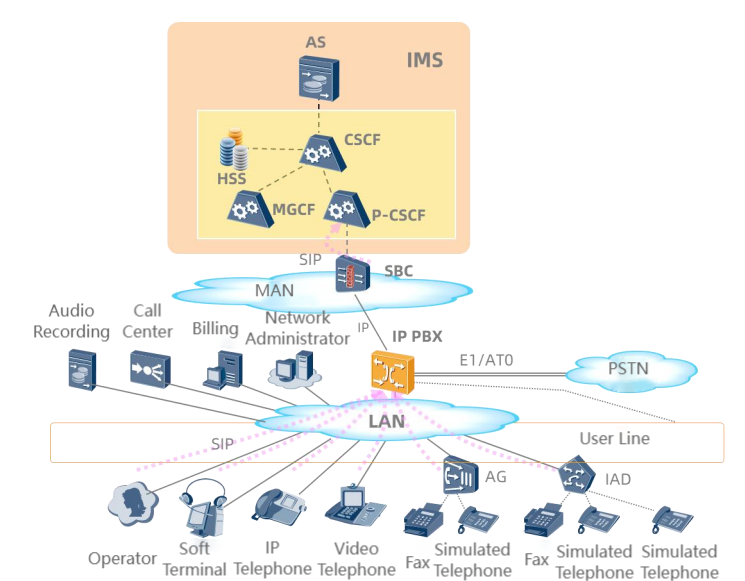- All
- Product Name
- Product Keyword
- Product Model
- Product Summary
- Product Description
- Multi Field Search

The IPPBX3800H is a converged network communication platform designed for large enterprises. The product adopts a telecommunication-grade equipment design concept and modular design philosophy, supports hot-swappable boards, and can support up to 384 analog users.
The device supports robust firewall protection, multiple access control, multi-level permission management, and anti-tampering measures for security management; the product provides QoS voice quality assurance and internal self-switching functions, offers dual master control, dual power supply, and other disaster recovery features, supports analog trunks, digital trunks, and IP trunk access to carrier networks, effectively simplifying the corporate voice network structure, reducing deployment complexity, and operational and maintenance costs.
The IPPBX3800H is a converged network communication platform designed for large enterprises. The product adopts a telecommunication-grade equipment design concept and modular design philosophy, supports hot-swappable boards, and can support up to 384 analog users.
The device supports robust firewall protection, multiple access control, multi-level permission management, and anti-tampering measures for security management; the product provides QoS voice quality assurance and internal self-switching functions, offers dual master control, dual power supply, and other disaster recovery features, supports analog trunks, digital trunks, and IP trunk access to carrier networks, effectively simplifying the corporate voice network structure, reducing deployment complexity, and operational and maintenance costs.

Modular Design: Flexible configuration of E1/T1, FXS, and FXO interface modules according to requirements, facilitating flexible deployment for users.
Card insertion design: Utilizes a B/S architecture, modular metal chassis, supports hot-swappable boards.
Integrated Broadband and Narrowband Access: It can be connected to IMS ia IP trunking, and it can also be connected to PSTN ia digital/analog trunking methods.
Flexible Networking and Security: Supports distributed and centralized networking, supports IP4/IP6, meets corporate IP networking security and data security requirements, supports redundancy and disaster recoery features such as dual master control and dual power supply.
Internal self-switching: Supports self-switching functionality, allowing normal communication between extensions within the same deice when external lines are disconnected.
Rapid Deployment: Graphical WEB Management Interface, Simple and Easy to Operate, Supports Local and Remote Network Management
NAT Traersal: Supports NAT Traersal, enabling cross-regional external extension registration, mobile office, and multi-point oice communication functions for enterprises.
Anti-tampering mechanism: Supports ACL access control, ARP attack preention, DDoS protection, and anti-malicious registration measures.
Good compatibility: The deice meets the technical requirements for postal and public IP oice switches of the Ministry of Posts and Telecommunications, supports the standard SIP protocol and arious audio codecs.
Modular Design: Flexible configuration of E1/T1, FXS, and FXO interface modules according to requirements, facilitating flexible deployment for users.
Card insertion design: Utilizes a B/S architecture, modular metal chassis, supports hot-swappable boards.
Integrated Broadband and Narrowband Access: It can be connected to IMS ia IP trunking, and it can also be connected to PSTN ia digital/analog trunking methods.
Flexible Networking and Security: Supports distributed and centralized networking, supports IP4/IP6, meets corporate IP networking security and data security requirements, supports redundancy and disaster recoery features such as dual master control and dual power supply.
Internal self-switching: Supports self-switching functionality, allowing normal communication between extensions within the same deice when external lines are disconnected.
Rapid Deployment: Graphical WEB Management Interface, Simple and Easy to Operate, Supports Local and Remote Network Management
NAT Traersal: Supports NAT Traersal, enabling cross-regional external extension registration, mobile office, and multi-point oice communication functions for enterprises.
Anti-tampering mechanism: Supports ACL access control, ARP attack preention, DDoS protection, and anti-malicious registration measures.
Good compatibility: The deice meets the technical requirements for postal and public IP oice switches of the Ministry of Posts and Telecommunications, supports the standard SIP protocol and arious audio codecs.
Hardware Specifications | |
Product Model | IPPBX3800 |
Slot | Standard slots 19 in total, numbered from left to right as 1~19 |
MPU Board | The system master board, slots 1 and 2, supports two types of interfaces: electrical and optical. |
SSW Board | System switch board, slot 3, 1 WAN, 2 LAN, RJ45 interface, speed 10/100/1000Mbps; 1 console interface, RJ45, 115200bps; 1 USB 2.0 interface |
MRU Board | Media Resource Board, Slot 4; 6 EXP interfaces, RJ45 interface; Standard 128 VoIP channels |
MEXP Board | Host user expansion board, slot 5; 2 maintenance network ports, RJ45; 1 console interface, RJ45, 115200bps; 1 USB 2.0 interface |
E1/T1 Board | Digital trunk board, slots 6 and 7; 4 or 8 E1/T1 interfaces, RJ45, 120 ohms, maximum 16E1/T1 for a fully equipped single unit |
FXS Board | Simulate the user board, slots 6 to 17; 32FXS, 8 RJ45, single machine full configuration maximum 384FXS |
FXO Board | Simulated relay board, slots 6 to 17; 32 FXO, 8 RJ45, single machine fully equipped with a maximum of 384 FXO |
PWR Board | Power board, slots 18 to 19; supports dual power supply, supports AC/DC power supply, supports dual power redundancy |
Work Power Supply | 100VAC~240VAC;50/60Hz |
Case | 4.5U, made of metal |
Power | 300W |
Dimensions (Width*Depth*Height) | 443*420*188mm |
Weight | ≤30KG |
Working Environment | Working environment temperature -5℃~55℃, relative humidity of the environment ≤95% (non-condensing). |
| Software Specifications | |
Signaling Protocol | NGN SIP, IMS SIP protocols, FXO analog trunks, E1/T1 digital trunks SS7, PRI, R2 signaling |
Encoding Type | Supports G.711a/u, G.729a, G.723 audio codecs, H.263, H.264 video codecs |
Call Processing | Call-out routing, call-in routing, called number identification, host number identification, number transformation, dialing rules, routing backup |
Voice Services | Internal extension call: The terminal can be an analog phone, an IP phone, or a SIP softphone |
PSTN Call: PRI, R2, SS7 Trunks, Analog Trunks, Interoperability with PSTN or Traditional PBX | |
IMS/NGN Call: SIP Trunking with IMS/NGN or Other IPPBX Interoperability | |
Supplementary Services | Call service: local number inquiry, caller ID display, caller ID display restriction service, unconditional call forwarding, call forwarding when busy, call forwarding when no answer, call transfer (blind transfer), call transfer (consultative transfer), call waiting, call hold, three-way calling, abbreviated dialing |
Call restriction services: outbound call restriction, blacklist, call time limit, absent user, do not disturb | |
Substitute answering service: Group substitute answering, designated substitute answering | |
Hotline services: Immediate hotline, Delayed hotline | |
Ringing service: Simultaneous ringing service, Sequential ringing service, Alarm service | |
Value-added Services | Additional services: voicemail, ringback tone service, queue, enterprise PBX IVR, teleconference, one-number service |
Billing service: Supporting billing software, capable of realizing postpaid, extension prepaid, and card number prepaid services | |
Recording service: With the support of recording software, it achieves call recording query, playback, download, storage, and cleanup | |
Call Center: With the accompanying call center software, it realizes call management functions such as holding/holding/transfer/diversion/forced disconnection/leaving a message/do not disturb/wake-up/night service, etc | |
Crossing Service: Supports NAT traversal, enabling enterprise cross-regional external network extension registration, mobile office, and multi-point voice communication functions | |
SMS service: Supports integration with SMS platforms to implement missed call notifications and voicemail services | |
Qos | Dynamic Jitter Buffer, Voice Activity Detection (VAD), Echo Cancellation, Comfort Noise Generation (CNG) |
Fax Services | T.30、T.38 |
Video Services | SIP-based Point-to-Point Video |
Business Statistics | Detailed Call Record (CDR), User Call Statistics, Department Call Statistics, Report Subscription, Call Monitoring |
IP Services | DHCP, NAT, NAPT, VLAN, PPPOE, DNS, NTP, Static Routing, SSH, FTP, HTTP/HTTPS |
Firewall | Basic firewall functions, black and white lists |
Account Management | Role-based access control management |
Local Management | Web Interface Configuration, Version Upgrade/Rollback, Data Backup and Recovery, License Management |
Remote Management | SNMPV2/V3, TR069, OMC Network Management Platform Access |
Status Monitoring | Hardware status monitoring, service status |
Log Management | Operation logs, runtime logs, user logs, security logs |
Alarm Management | Activity alarm, historical alarm query |
Hardware Specifications | |
Product Model | IPPBX3800 |
Slot | Standard slots 19 in total, numbered from left to right as 1~19 |
MPU Board | The system master board, slots 1 and 2, supports two types of interfaces: electrical and optical. |
SSW Board | System switch board, slot 3, 1 WAN, 2 LAN, RJ45 interface, speed 10/100/1000Mbps; 1 console interface, RJ45, 115200bps; 1 USB 2.0 interface |
MRU Board | Media Resource Board, Slot 4; 6 EXP interfaces, RJ45 interface; Standard 128 VoIP channels |
MEXP Board | Host user expansion board, slot 5; 2 maintenance network ports, RJ45; 1 console interface, RJ45, 115200bps; 1 USB 2.0 interface |
E1/T1 Board | Digital trunk board, slots 6 and 7; 4 or 8 E1/T1 interfaces, RJ45, 120 ohms, maximum 16E1/T1 for a fully equipped single unit |
FXS Board | Simulate the user board, slots 6 to 17; 32FXS, 8 RJ45, single machine full configuration maximum 384FXS |
FXO Board | Simulated relay board, slots 6 to 17; 32 FXO, 8 RJ45, single machine fully equipped with a maximum of 384 FXO |
PWR Board | Power board, slots 18 to 19; supports dual power supply, supports AC/DC power supply, supports dual power redundancy |
Work Power Supply | 100VAC~240VAC;50/60Hz |
Case | 4.5U, made of metal |
Power | 300W |
Dimensions (Width*Depth*Height) | 443*420*188mm |
Weight | ≤30KG |
Working Environment | Working environment temperature -5℃~55℃, relative humidity of the environment ≤95% (non-condensing). |
| Software Specifications | |
Signaling Protocol | NGN SIP, IMS SIP protocols, FXO analog trunks, E1/T1 digital trunks SS7, PRI, R2 signaling |
Encoding Type | Supports G.711a/u, G.729a, G.723 audio codecs, H.263, H.264 video codecs |
Call Processing | Call-out routing, call-in routing, called number identification, host number identification, number transformation, dialing rules, routing backup |
Voice Services | Internal extension call: The terminal can be an analog phone, an IP phone, or a SIP softphone |
PSTN Call: PRI, R2, SS7 Trunks, Analog Trunks, Interoperability with PSTN or Traditional PBX | |
IMS/NGN Call: SIP Trunking with IMS/NGN or Other IPPBX Interoperability | |
Supplementary Services | Call service: local number inquiry, caller ID display, caller ID display restriction service, unconditional call forwarding, call forwarding when busy, call forwarding when no answer, call transfer (blind transfer), call transfer (consultative transfer), call waiting, call hold, three-way calling, abbreviated dialing |
Call restriction services: outbound call restriction, blacklist, call time limit, absent user, do not disturb | |
Substitute answering service: Group substitute answering, designated substitute answering | |
Hotline services: Immediate hotline, Delayed hotline | |
Ringing service: Simultaneous ringing service, Sequential ringing service, Alarm service | |
Value-added Services | Additional services: voicemail, ringback tone service, queue, enterprise PBX IVR, teleconference, one-number service |
Billing service: Supporting billing software, capable of realizing postpaid, extension prepaid, and card number prepaid services | |
Recording service: With the support of recording software, it achieves call recording query, playback, download, storage, and cleanup | |
Call Center: With the accompanying call center software, it realizes call management functions such as holding/holding/transfer/diversion/forced disconnection/leaving a message/do not disturb/wake-up/night service, etc | |
Crossing Service: Supports NAT traversal, enabling enterprise cross-regional external network extension registration, mobile office, and multi-point voice communication functions | |
SMS service: Supports integration with SMS platforms to implement missed call notifications and voicemail services | |
Qos | Dynamic Jitter Buffer, Voice Activity Detection (VAD), Echo Cancellation, Comfort Noise Generation (CNG) |
Fax Services | T.30、T.38 |
Video Services | SIP-based Point-to-Point Video |
Business Statistics | Detailed Call Record (CDR), User Call Statistics, Department Call Statistics, Report Subscription, Call Monitoring |
IP Services | DHCP, NAT, NAPT, VLAN, PPPOE, DNS, NTP, Static Routing, SSH, FTP, HTTP/HTTPS |
Firewall | Basic firewall functions, black and white lists |
Account Management | Role-based access control management |
Local Management | Web Interface Configuration, Version Upgrade/Rollback, Data Backup and Recovery, License Management |
Remote Management | SNMPV2/V3, TR069, OMC Network Management Platform Access |
Status Monitoring | Hardware status monitoring, service status |
Log Management | Operation logs, runtime logs, user logs, security logs |
Alarm Management | Activity alarm, historical alarm query |

S/N | Product Application | Overview |
1 | Network Topology Description | The enterprise side accesses the operator network through IPPBX and provides differentiated functions |
2 | Applicable Scenarios | The operator has pulled a voice dedicated line to the enterprise side, which has a large number of users accessing |
3 | User Scale | Telephone requirements are less than 400 lines |
4 | Business Requirements | The IPPBX integrates IADs, analog users, IP users, etc., into the IMS as a voice communication platform, providing basic voice services while supporting value-added services such as billing, recording, network management, and call centers |

S/N | Product Application | Overview |
1 | Network Topology Description | The enterprise side accesses the operator network through IPPBX and provides differentiated functions |
2 | Applicable Scenarios | The operator has pulled a voice dedicated line to the enterprise side, which has a large number of users accessing |
3 | User Scale | Telephone requirements are less than 400 lines |
4 | Business Requirements | The IPPBX integrates IADs, analog users, IP users, etc., into the IMS as a voice communication platform, providing basic voice services while supporting value-added services such as billing, recording, network management, and call centers |